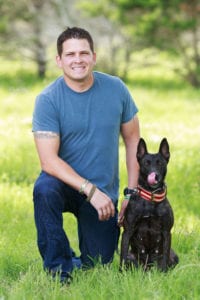Potty Training Tips
At Patriot Dog Training, we got a ton of questions about how to train your dog at home and reinforce positive behaviors. One of the most common topics we get asked about is how to correctly potty train your dog. As always, we try to address many of these questions about San Antonio and Austin dog training in our monthly blog section.
This challenge is undoubtedly difficult for some pet owners leading to frustration. In extreme cases, this frustration can even lead to some dogs being rehomed or sent to a shelter. For years, many people believed that the best way to train a dog from going in the house was “shoving your dog’s face in it.” However, for most dogs, you have a very small window of time to notify the dog that what they are doing isn’t desirable behavior and to correct the action before the dog has moved on mentally. Going the old-school route doesn’t really help train the dog that the action was bad, but instead just makes them more fearful of you – which can lead to more anxious accidents. Instead of going this route, consider some helpful tips when trying to potty train your pup.
Tip #1 – Know Your Time Limits
You have to remember that dogs – and especially puppies – have different internal systems than we do. They’re smaller, more compact, and aren’t able to hold their bladder as long as humans. The age of your pup usually correlates to how long it can hold its bladder. A general rule of thumb is the number of hours a dog can hold its bladder is roughly even to its age in months, plus one or two. For example, if your pup is 4 months old, expect that the maximum wait time before he or she will need to go out again is roughly 5-6 hours. In puppies younger than two months old, aim for the low end of that spectrum. Once you’ve hit the maximum time limit, your pup may not be able to wait anymore, no matter where he or she is or how much you’ve been working on getting outside before nature calls.
Tip #2 – Stay Consistent
One of the biggest parts of puppy training in any regard, but especially in potty training or house breaking, is to keep up a solid routine (no pun intended). Dogs of all ages – but particularly young puppies – need structure and work well with patterns and routines. Dogs are creatures of habit. You’ll find that most mistakes and accidents occur when the routine is either changed or inconsistent. Keeping up a consistent approach will help establish good habits and the less variation the pup experiences in the beginning, the more longterm success they will experience.
Tip #3 – Keep Control
If a puppy is out roaming the house, it is extremely important to maintain control. Initially, they would be either tethered to me or next to me on a leash that I can pick up and grab when I notice them starting the process to use the bathroom. The teether allows me to not chase after the puppy and allows me to simply grab the end of the lead and walk them outside to their spot to use the potty. If they do not go and I know they need to go, we will return to the crate for 15-20 minutes and then try again. Keeping control of the situation greatly lessens the likelihood of accidents and helps reinforce positive training techniques for both the pet and the owner.
For this, I would recommend something like the Watfoon Dog Leash so that I don’t have to worry about the dog chewing it up.
Tip #4 – Don’t Lash Out
Imagine walking into the house and you notice that on the floor lies a fresh steamy “present” waiting for you. You walk over to the dog and you see your pup has this sad look on their face. You’re heated and the dog knows it because they can read your emotions. You then scold your dog for using the bathroom in the house. You say “he had a guilty look on his face, he must know he did something bad.” Let me honestly share the facts, dogs live and respond in the now, not the future or the past. It’s so important to remember this, the current state of your behavior and the emotions that you are expressing produces the dog’s “sad” face.
Tip #5 – The Crate Is Your Friend
You’ll see that crate training will absolutely improve your dog’s success at potty training. I will discuss crate training later. Some crates that I absolutely love are Ruff Tough Kennels, Gunner Crates and Impact Crates. There are plenty of cheaper options out there, but I’ve never been disappointed by these types of crates.
Tip #6 – Don’t Get Frustrated
Accidents happen. It’s a process. There are going to be times that you feel frustrated, even if the training is going well. Typically, when you look back over the course of the dog’s training, you’ll see that 99% of the accidents the dog has had are, indeed, the trainer’s fault. It’s happened to me hundreds an of times! When looking back at why a dog had an accident, I thought “what did I do wrong” or “what could I do better?” So when you get all angry, find that happy smile and continue pushing forward.
Here’s an example. I had a 10 week old puppy. I had it on a tether and let it roam free. That was my first mistake. So what did it get to do? Roam the house. Then it had an accident. I didn’t catch it in time, this was my second mistake. This was all my fault. He had the dang tether on it so, why didn’t I just put my foot on it while I was reading my book? Rather than getting frustrated with the dog, or even moreso, with myself, keeping a bright outlook and knowing that mistakes like this are part of the process helps to keep from feeling overwhelmed by the entire training procedure.
Conclusion
Follow these simple guidelines, and you’ll be living in an accident-free home in no time. Or, if you’d rather, you can always bring your pet out to Patriot Dog Training here in Bulverde for professional puppy training or San Antonio dog training. We offer potty-training as part of many of our packages, and we’ve gotten some of the best results in the San Antonio or Austin area from our work with dogs and puppies of all ages and skill levels. If your dog needs a crash course in canine obedience, reach us via the contact form, or call our team at 830-229-7141.






